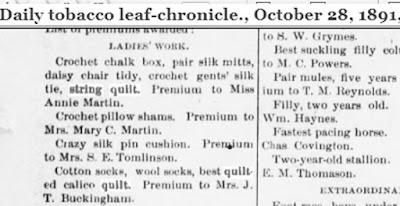A string quilt pieced of odd shaped strips of fabric,
about 1910
String star about 1900
Six-Point String Quilt, Kansas City Star, 1940
String quilts aren't often found in the quilt pattern literature, although the folklore literature
contains information, such as the pattern sketch below from a 1920 issue of the Journal of American Folk-Lore.
Family with a similar quilt
Ruby Short McKim published a pattern for a String Quilt in her 1931 book 101 Patchwork Patterns, but she drew templates---not the traditional way to make a string quilt. And that is probably why so little was published about the topic.
You don't need a pattern; therefore there was nothing to buy.
String quilt by an Illinois Amish quiltmaker
We can look at string quilts as the Cinderella of quilt history, with little published about them until they began to be appreciated at the end of the 20th century. But several quiltmakers recorded memories of string quilts, giving us some insight into the process and their status in the hierarchy of fancy versus plain quilts.
Pecolia Warner (1901-1983) in 1975
with one of her "P Quilts"
Folklorist William Ferris interviewed Pecolia Warner of Mississippi for his book Afro-American Folk Art and Crafts. She told him the difference between a "fancy quilt" and a string quilt.
"You can sit down and make them string quilts real quick. For a string quilt, I just commence to piecing up blocks out of strings — they're scraps, you know, I have from sewing, and some that other people save for me. Like that Six Strips quilt I made, that ain't nothing but a lot of string sewn together. That way you won't throw away any pieces. See, when you get a box full of strings, you got about five or six quilts. With string quilts you ain't got nothing to throw."
Set of blocks pieced over magazine and newspaper pages
Cyrilla Miller Bencaz from the Louisiana project & the Quilt Index
"No quilter interviewed considered a String quilt one of her show pieces, yet some are quite beautiful. 'It's just an old String quilt,' said one quilter, giving a typical response to an inquiry about a quilt using irregular shapes and sizes of brightly colored prints and solids. They had been sewed onto a square newspaper pattern with ends protruding around the edges at random. The squares were trimmed..."
Most people removed the paper although
shreds sometimes cling to the back.
String blocks pieced over triangular foundations
"Ivory Pitchford's first quilt was a string quilt that her mother taught her to make. She started it at about the age of 16, constructing blocks about the size of a napkin from 'strings' of fabric. She quilted it herself, in 'shares' or sections, just as her mother did. Over the years, Pitchford has made quite a few string quilts, including one for each of her five boys."Quilting in shares or sections might refer to quilting by the block rather than using an all over pattern.
From 1910-1940 perhaps, quite a mixture of fabrics
In a 1988 Threads magazine story Willia Ette Graham of Oakland, California explained "You don't have to cut for a string quilt," using the scraps as she found them.
In 1891 Annie Martin won a prize with her collection of Ladies' Work, including a string quilt. at a Clarksville, Tennessee fair. Mrs. Buckingham entered a calico quilt, a different item, apparently.
From Shelly Zegart's inventory
Strings are pieced over the paper and the paper trimmed to the correct shape.
Popular string quilt design sometimes called Snowball...
or Fireball if the quarter circle is red.
Those names were published in Quilt World magazine in 1979.






















String quilts have such charm! Just "an old string quilt" I love it!!
ReplyDeleteSimply brilliant what those gals did with scraps and "no pattern."
ReplyDeleteI've been looking at string quilts for my next RSC project all day today! Enjoyed these.
ReplyDeleteI love string quilts and prefer making up my own patterns - thanks for this marvelous post.
ReplyDeleteBeautiful. love it!
ReplyDelete